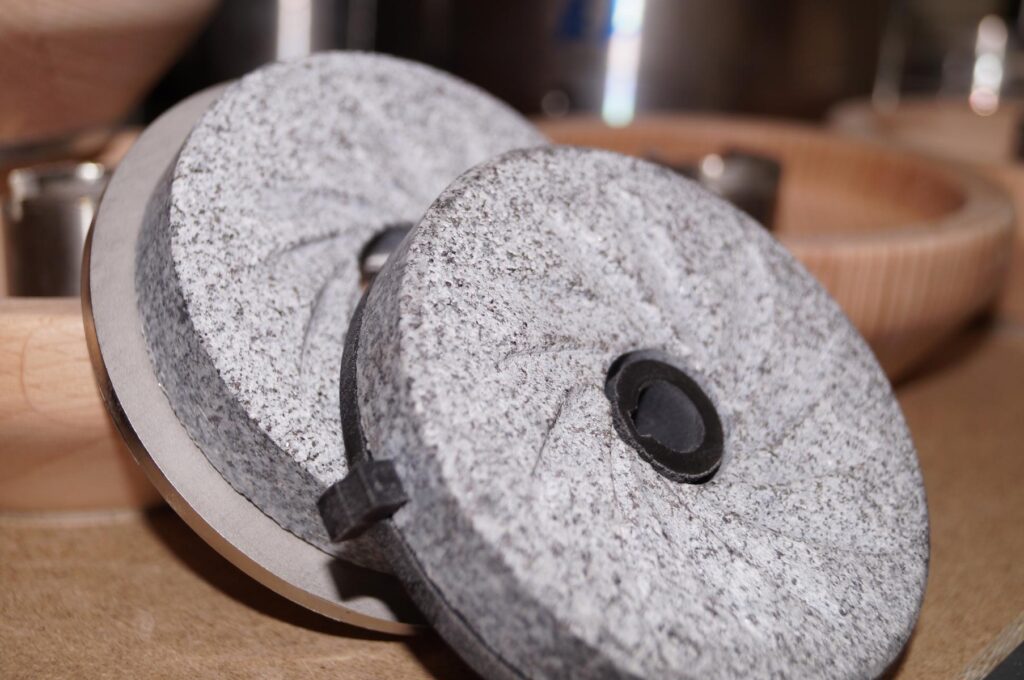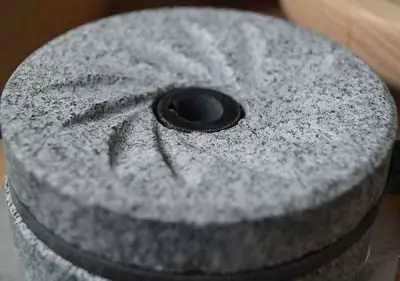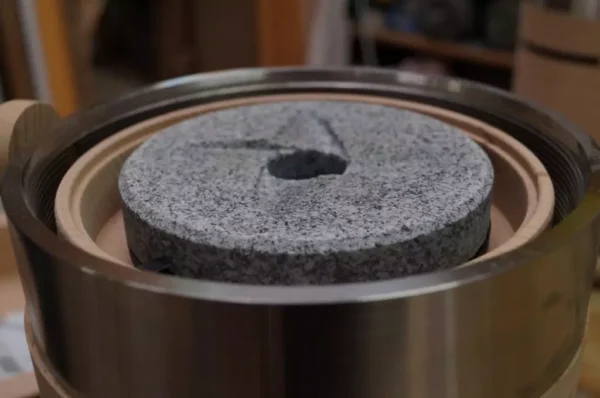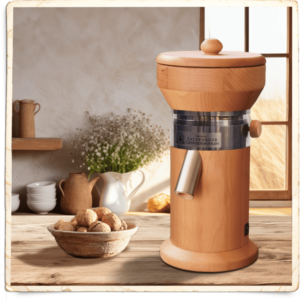
From experience and full conviction, we decided in 2016, under the name Salzburger Getreidemühlen, to exclusively manufacture mills with granite milling stones sourced from nature. The decisive factors for this decision were the convincing properties:
The flour from natural stones can hardly be described in words… airy, powdery, velvety, soft.
These words are not enough. You must feel the flour between your fingertips.
Flour that you buy pre-packaged in stores is categorized into types and made in standardized processes.
Grind your own with an original Salzburger grain mill and experience the differences and special qualities of the flour already in the bowl that catches your flour under the spout. How it piles up into flour cones and slides down, how it can be easily shaken, or later during kneading behaves, unfolds during baking, and ultimately reveals itself in the outstanding taste.
Words from experienced bakers count here more than the standards of the industry.
„Only with it will it work – with the flour from my Salzburger,” a farmer from Upper Austria told us at an exhibition, who always bakes a specific cake for her small community for the harvest festival. And you could literally see the pride in her eyes.
 From granite block to milling stone:
From granite block to milling stone:Our granite stones are carefully and patiently matched in pairs and crafted by hand.
The production of our milling stones begins with a raw stone blank, to which the basic shape of the millingsurfaces and perfect roundness are given.
Then follow several uncompromising optimization steps, in which perfection is worked out through milling tests, rebuilding, and resharpening to achieve the desired fineness of the flour and milling performance.
It is a matter of experience and something very individual, which shape the expert gives to the stone, until hard and bulky grains such as rice or chickpeas are ground as finely as rye and wheat.
It’s almost like building a musical instrument, where usually several approaches lead to an outstanding result.
Now you understand the effort required to transform the granite blocks quarried in the stone quarry into small, round, perfectly balanced milling stones. And how simple it is, by comparison, to manufacture artificial milling stones from corundum ceramic, pressed into shape with chemical binders, in a high-temperature furnace.

Our search for the right granite for our mills began over 40 years ago. Even in our pioneering days in the 1970s, we started looking for “the stone.” We searched for years in Austria, Germany, and all over Europe, testing the advantages and disadvantages of various natural stones to find the most suitable granite for the Salzburger MT series.
Even today, the blocks are mined in the same area in Europe, but our knowledge of the value of these stones is much greater. More than ever, we appreciate properties like hardness, self-sharpening, and durability and especially the quality of the flour that can be made with granite stones.
Also, we, Salzburger mill builders, can today proudly claim to be the only ones in Europe who have over 40 years of experience with granite milling stones for electric household mills.
Over 40 years ago, Eng. Johann Thurner set the ambitious goal to develop the best possible adjustment system for his mills.
Since then, a precise steel thread, with the solid diameter of the mill’s casing, adjusts the distance between the two milling stones.
A system that continues to produce the finest flour, even after decades, in many mills worldwide.
Today, modern CNC facilities manufacture the thread, in the highest precision, no longer from steel but from the highest quality available stainless steel alloy.
The weight of the thread of the mill MT 12 is about 3.5 kg with a diameter of 16.5 cm.
This massive component owes a Salzburger grain mill the stability and robustness to perfectly align the two milling stones.
This guarantees the finest flour for decades and no change in flour fineness during milling
The symbiosis of the adjustment with the milling stones
Each adjustment system sets the distance between the lower and upper milling stones. The stones grind always in direct interaction with the adjustment to produce fine or coarser flour – just as you wish.
For the fineness of your flour, therefore, not only the stones but equally the adjustment system are important.
Whether you turn a control wheel or a funnel, or operate a slider, you always change the distance of the stones.
If an adjustment system does not work precisely, then the milling stones are not exactly flat (i.e., they do not lie exactly parallel to each other). Then the stones cannot grind the finest flour and the coarse part of the flour is greatly increased.
But how often do you hear: My mill is only 10 years old (the problem can occur sooner or later) and no longer grinds fine! Most often in this case, the adjustment system is to blame and not the milling stones, as often assumed.
The stainless steel thread guarantees that the set degree of fineness does not change during milling.
For a layperson, it may be difficult to assess the value of the stainless steel thread. But technicians, metalworkers, etc., know about the material costs, the manufacturing costs, the demands on precision, etc.
For decades, our stainless steel threads work millimeter-precisely and not only when you grind favorite grains like wheat, rye, or spelt, but also hard and large grains such as corn, chickpeas, or beans.
A thread made of stainless steel is uncompromising quality from the first to the last minute of milling – over decades!
The coarse-fine adjustment is one of the most important parts of our grain mills. Each degree of fineness is continuously adjustable by hand – even during milling.
Whether you want to grind the finest flour or coarse meal for your breakfast cereal – you choose the flour fineness by turning the adjustment knob.
This is placed in the upper third of the mill on the side and can be turned clockwise or counterclockwise.
By turning the adjustment knob, the lower milling stone moves up or down. This changes the distance between the upper and lower milling stones and thus the flour fineness.
The upper milling stone is firmly connected to the funnel and does not change its position.
This ingenious adjustment system has proven to function even after decades.
It is essential that the quality of the execution of the adjustment system ensures that the milling surfaces of both stones are always perfectly aligned parallel to each other and that their distance does not change during the milling process.
We do not use today’s common plastic threads. Through our perfect technical solution, by an eccentric mechanism, the milling stones lie exactly parallel to each other for decades.
In the milling chamber, the wood of the grain mill is subject to the greatest stress. With great force, the milling stone crushes the grain, which rubs against the outside, the walls of the milling chamber.

According to the latest findings, natural beech wood has antibacterial properties! It is also well known that wood acts antistatically!
A wood milling chamber hardly charges electrostatically during milling and thus also transfers hardly any electrostatic charges to the flour.
Many other mill manufacturers have opted for food-safe plastic – but we remain true to our tradition and prefer wood milling chambers – a rarity!
Cleaning the milling chamber is not laborious and only necessary from time to time. Using the mill regularly is the best thing you can do. Regular use also prevents moths or other pests from nesting in your mill.
Wood is part of human history and is a living, organic material.
Real wood is nature and fulfills the desire for authenticity in an artificial world.
Anyone who owns a natural wood kitchen appreciates the advantages of wood. In a solid wood body, food stays fresh longer, bread does not start to mold, etc.
Recent studies have even demonstrated the bacteria-inhibiting properties of natural materials.
On untreated wooden surfaces, germs cannot grow.
Wood, due to its cellular composition, with an almost unimaginably large surface area, has a strong hygroscopic effect. The associated water withdrawal creates a hostile environment for bacteria, leading to their death.
Wood & Hygiene has been a research focus at the Institute of Wood Research at the University of Natural Resources and Life Sciences, Vienna for several years.
Antibacterial properties of wood proven
Dr. Alexandra Makulla Press Office
Federal Biological Research Centre for Agriculture and Forestry
Wood as an effective bacteria killer confirmed in scientific study
holzvomfach.de – Expert Knowledge
wilms.com – Wood & Hygiene

Thus, the appearance of the mills matched the taste of the time and they fit well into the typical living rooms and kitchens of Austria and Bavaria.
To fulfill a heartfelt wish for his wife Monika, Eng. Johann Thurner at that time set himself the task of not only building a technically perfect mill but also one that he considered truly beautiful. Accordingly, he spent a lot of time thinking about the appearance of the mill:
What shape suits a grain mill from Salzburg? It quickly became clear to him: It should be round, like the Salzburg Mozartkugel!
As a child and teenager, Johann Thurner was already talented in drawing, and we owe the timelessly beautiful shape of the MT series – the Original Salzburger Grain Mill to his pencil.
For decades, it has been referred to by many as “the queen of mills” or sportily as “the Mercedes among mills.”
However, not only taste but also budget often plays a role in choosing a mill.
The fact that round wooden parts with steel elements are significantly more expensive than square ones later led us to conceive a particularly budget-friendly mill.
The AM 1 was the beginning, and the models MAX, and MAX SPEZIAL followed.
Good design is more than just styling, more than a creative solution for technical, aesthetic, and functional requirements.
Today, good design also encompasses sustainability and environmental friendliness.
Address:
Gasteigweg 25,
5400 Hallein
Austria
Opening hours:
Monday to Thursday: 09 – 16:00
Friday: 09 – 12:00
Contact:
Phone: +43 6245 83282
E-mail: info@agrisan.at
Address:
Gasteigweg 25,
5400 Hallein
Austria
Opening hours:
Monday to Thursday: 09 – 16:00
Friday: 09 – 12:00
Contact:
Phone: +43 6245 83282
E-mail: info@agrisan.at

